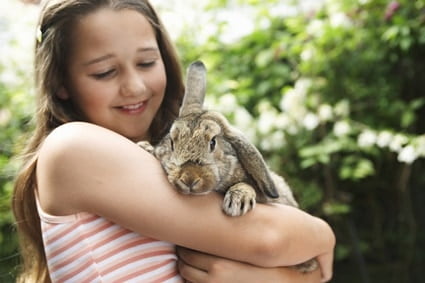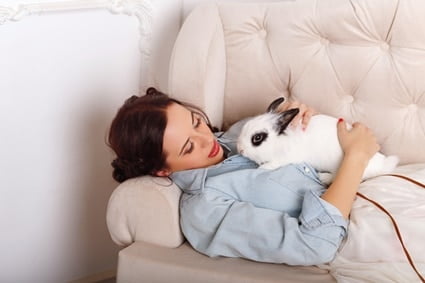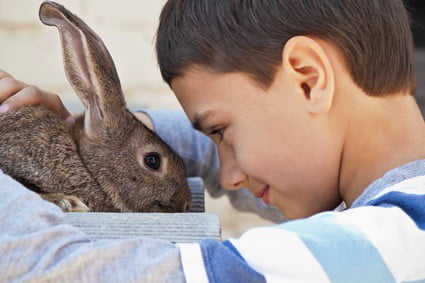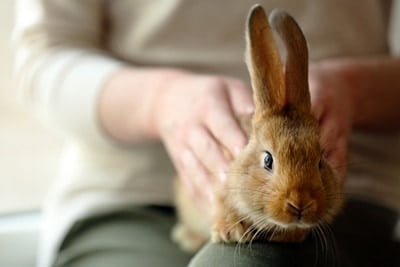Rabbits are affectionate creatures, but they’re not well-known for enjoying cuddles. While dogs and cats enjoy petting sessions, you may be unsure where to stroke a rabbit. The good news is, bunnies love being pet, so long as you know the right places.
Rabbits love being pet on the forehead, back of the neck, and cheeks. Most rabbits will also love full back massages along the spine, so long as you avoid the butt and tail. These areas sit in a rabbit’s blind spot, and contact here will startle it. A favorite petting spot will depend on the rabbit. Paying close attention to how your bunny reacts during the petting session will help you learn its preferences.
A rabbit will seek you out for such affection once it trusts you. So, owners need to allow the rabbit to negotiate petting sessions. Most will dislike being pet under the chin, on the feet, and under the belly and neck. These are vulnerable areas, and rabbits may defend them with nips and bites. Otherwise, rabbits love receiving such affection from their owners.
Do Rabbits Enjoy Being Petted?
Rabbit not only like being pet – they love it. Although some owners will say the opposite, the idea that rabbits are fully anti-social comes from poor ownership. A rabbit will not immediately accept pets from strangers or new owners. Expecting otherwise can lead to your bunny refusing any petting.
That’s because rabbits are slow to build trust. They evolved as prey animals, and Conservation Biology notes that rabbits serve as prey for a large number of predatory animals. Having evolved under the pressure of surviving predators, many actions that you take can frighten your rabbit.
This includes petting it in the wrong way, or picking it up for petting. Repeating these mistakes a number of times can teach the rabbit that it needs to avoid you. As a result, you may think your bunny just hates being pet. In reality, it’s the bunny’s way of establishing boundaries.
Difficult as it might be, it’s important to let the rabbit approach you when it’s ready. Allow it to set its own boundaries around petting and focus on developing a bond. Once you have, you’ll build a happier, healthier, and more affectionate relationship with your rabbit.
Is It Good To Pet A Rabbit?
Petting a rabbit isn’t just a nice pastime for you and the bunny. It has many social and physical advantages for the rabbit:
Bonding
By allowing (and enjoying) petting sessions, a rabbit is showing trust. As such, petting your rabbit frequently will tell it that it’s safe under your hands. The more often that’s proven, the stronger your rabbit’s bond with you becomes.
This will then motivate the rabbit to be friendlier in other ways. For example:
- Sleeping on you
- Eating out of your hand
- Playing with you
- Even responding to a call from you
This also helps your rabbit become friendlier with other humans. By petting it often, you’re socializing the rabbit to human companionship. As intelligent animals, bunnies need regular interaction with people to stay happy and fulfilled.

Grooming
Petting is, in a way, a substitute for grooming. Unless you’re doing this with a brush or comb, it won’t actually clean the fur. However, it does mimic the feeling of other rabbits cleaning each other’s fur. This is a crucial social practice that can help the rabbit feel its needs are met.
That is doubly important if the rabbit is a solo pet and lacks another rabbit for companionship. In that case, the bunny may develop a feeling of loneliness and isolation.
Calming
Petting is a useful method for calming an anxious or angry rabbit. The gentle stroking will serve as a distraction and a sign of protection. This serves two functions:
- Give your rabbit a chance to settle down
- Reaffirms that outside dangers are less severe if you’re present
Eases Actual Grooming
Regular close-contact sessions help your rabbit get accustomed to being handled. This is useful when you need to perform grooming maintenance, such as ear cleanings or nail trimmings.
How Often Do Rabbits Want To Be Pet?
Every rabbit is an individual. Some will come running for pets and cuddles at all hours. In contrast, others may only enjoy a short cuddle session after a meal. Properly socialized rabbits that feel safe in their home may even run up to guests for cuddles. This is not always the case, however, especially with new strangers.
How Do I Know If My Rabbit Likes Being Petted?
Most rabbits will actively seek out attention when they trust their owners, with behavior such as:
- Digging at your lap
- Sitting on your lap
- Nuzzling your hand
- Curling up next to you
These are all signs of affection and trust from a rabbit. When your bunny feels comfortable, it’s also a request for petting.
These are obvious signs, of course. You may also encounter requests for pets that are more confusing. These include:
Tooth Grinding
Tooth grinding is something that puzzles new owners. This is a rhythmic clicking noise, and it almost looks like the rabbit is chewing on food.
Tooth grinding is similar to purring in cats or tail-wagging in dogs. So, what if the rabbit begins tooth grinding during petting or grooming sessions? It means the bunny is happy and enjoying the moment.
Resting Its Head On You
What if your rabbit sits next to you, but not on your lap? Although subtle, this is also a show of affection. The rabbit may settle down and rest its head on the ground, or on you, depending on where it is sitting. The rabbit may even close its eyes in contentment.
For some rabbits, it’s a request for petting. For others, it’s their way of enjoying your presence, but they don’t want pets. How can you tell which is which?
- Try petting your rabbit slowly at first, and then stop.
- Rest your hand near its face.
- If the rabbit nudges your hand, it is asking for you to continue the petting. If it doesn’t respond, then leave it alone.

Where Do Rabbits Like To Be Petted?
When it comes to petting, every animal has its favorite spot. Likewise, every animal has spots where it hates being pet. Across all breeds of rabbits, however, there are certain places that are favored overall.
An exception is rescue animals, which may have issues with being touched. Rehabilitation is possible in most cases, with patience and the right handling. Just be sure to approach these favorite petting spots carefully.
If the rabbit doesn’t appear to like it, stop and try somewhere else. Your rabbit’s preferences must be respected. Not doing so can damage your relationship.
Do Rabbits Like Their Heads Stroked?
Rabbits thoroughly enjoy forehead scratches, Petting the slope of their heads is also ideal. You’ll likely see your rabbit relax into a happy puddle of fur after petting this spot for a while.
Although some rabbits can be head-shy, most like their heads stroked. If your bunny appears to shift away as you reach for its head, then respect its wishes.
Do Rabbits Like Their Nose Rubbed?
Rabbits are very expressive, in their own way. Rubbing noses can mean a variety of things, such as:
- An apology
- An acknowledgement of the social hierarchy
- A show of dominance
Given the broad range of meanings, some rabbits will hate their nose being rubbed. Others will enjoy a little nose tickle here and there. Test out how your rabbit reacts by gently rubbing your thumb over its nose.
- It may have no response at all. This means it doesn’t have an opinion on the touch.
- It may recoil. A negative response means you should back off and not touch the nose again.
- If a rabbit rubs its nose against yours, it’s a show of affection. Rubbing its nose anywhere else is a request for attention, pets, or food.
The bridge of the nose may be well-received, so long as you avoid contact with the nose pad itself.
Do Rabbits Like Their Cheeks Rubbed?
Rabbits love having their cheeks rubbed. This can be a sweet spot for breeds, no matter their age.
If your rabbit doesn’t seem fond of this spot, then getting the bunny accustomed to it may be useful. By feeling the jaw and teeth through the rabbit’s cheeks, you can better monitor its dental health.
Rabbits need grass hays to shave down their teeth, which are constantly growing. The Journal of Exotic Pet Medicine states that the rate at which the rabbit’s teeth grow is relatively fast, at 2-2.4mm per week. As such, your rabbit can benefit from acclimatizing to cheek pettings. Dental issues can spring up faster than you think.
Do Rabbits Like Being Pet While Eating?
Rabbits are extremely vulnerable while eating. After all, they’re distracted, have their heads down, and their hearing is muffled by chewing sounds. For this reason, a rabbit may dislike being pet while it’s eating. It may even shy away from your touch. If this is the case, leave it alone while it eats. However, some rabbits may not care at all if you pet them during meals.
In any case, most bunnies settle down and relax after a meal. If you want to pet a new or anxious bunny, this is the best time.
Do Rabbits Like Their Ears Stroked?
Contrary to popular belief, even a rabbit that trusts its owner will be hesitant to let its ears be touched or stroked. That’s because rabbit ears are very sensitive, delicate structures. Rough handling will cause pain or disorientation, so the bunny will react negatively.
Note that some bunnies will refuse all ear petting. Here, it’s important to respect your rabbit’s boundaries – except for hygiene purposes. You will need to clean your rabbit’s ears. Not doing so can result in an ear infection, or an ear mite infestation getting out of hand.
Most rabbits will adore being massaged at the base of the ears and along the neck. This is a great petting spot, and a good place to start easing your rabbit into ear touching. Over numerous petting sessions, gradually begin touching its ears with gentle passes of your hand.
Rabbits also usually love full-body massages, where you stroke your hand from forehead to just above its butt. A content rabbit will let its ears rest along the back of its neck. This helps you pass a hand over its ears without fuss.

Where Do Rabbits Hate Being Pet?
Rabbits enjoy a variety of petting spots – and hate others. As mentioned, there are benefits to working with your rabbit on some of these areas. However, not all carry a benefit.
Chin
Petting a rabbit under the chin isn’t going to earn a positive response. A rabbit will likely shy away from chin scratches. There isn’t a benefit to acclimatizing it to this touch either.
Butt Or Tail
Rabbits also do not like their butts or tails touched. These areas are in the rabbit’s blind spot, and so any touch can startle it.
Chest And Belly
Under the chest and belly are not blind spots, but they are jealously defended from any touch. That’s because these areas are the most vulnerable places on a rabbit’s body. It may nip, bite, kick, or otherwise warn you away from touching it here.
Feet
Lucky as rabbit feet are, your bunny may hate being pet there. Nonetheless, rabbits do need regular nail trimming. This prevents ingrown nails and overgrown nails, which cause painful foot issues. It also minimizes the risk of the bunny scratching you or any other individual.
All of these ‘no’ spots can seem a little odd. After all, cats love being scratched under the chin and dogs love belly rubs. Tame as they are, both of these animals are actually predators. They have very different responses and personalities compared to rabbits. In Practice notes that treating a rabbit as you would a cat or dog is a mistake that can lead to welfare issues.
How To Make Fuss of A Rabbit
Petting a rabbit means always remembering that it is a prey animal. No matter how closely bonded you are, take the following steps.
Keep Your Hand In Sight
Even if the rabbit approaches you for pets, make sure it can see your hand before making contact. A rabbit has two blind spots, directly behind its head and before its nose.
- You should bring your hand in from the side.
- Move slowly and calmly.
- If the bunny shies away, back off and allow it to come to you again.
Let The Rabbit Decide How Long Petting Lasts
Rabbits are affectionate, but they don’t communicate like people. It’s best to pay attention to your rabbits’ body language. Most will indicate when the petting should stop. This usually entails the bunny trying to get out of your lap, arms, or reach.
If your bunny tries to leave the petting session and you hold it close, this can result in aggression. Likewise, it may want many smaller petting sessions. Refusing it later can leave the bunny feeling unappreciated. So:
- Try to let the rabbit determine how long the petting session is to be.
- Don’t force it to stay longer.
Don’t Pick Up The Rabbit
Avoid picking up the rabbit, petting session or no, as this is not well-received by most rabbits. Being held simulates being restrained by a predator. It can trigger a fight-or-flight response. If you are holding the rabbit, it may jump from your grip and hurt itself quite badly.
Try To Massage, Not Roughhouse
Now, as for actually petting the rabbit.
- Smooth the flat of your hand over its head.
- Pass your hand gently along its spine.
- You can massage at the base of its ears and back of its neck with your fingers.
- A relaxed rabbit will let its ears rest against its neck. You can pass your hand over its ears too.
- Gradually build up to full body strokes that follow the curve of its spine.
What’s The Best Spot To Pet a Bun?
Every rabbit will have its own favorite spot for petting. As you massage the rabbit, these spots will reveal themselves. On the whole, though, a rabbit’s absolute favorite spots are usually:
- The cheeks
- The back of the neck
Petting your rabbit is an important bonding experience between rabbit and owner. Just be sure your rabbit can end the session when it pleases. By providing that control, it will feel safe to come over to request more attention.

